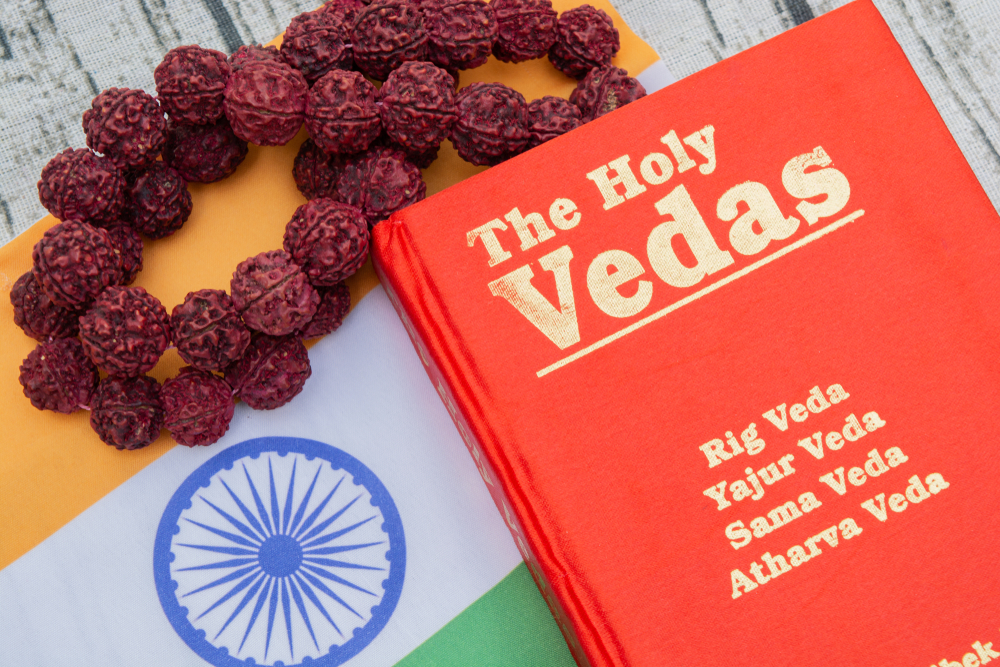
Many spiritual traditions rely on sacred or religious literature to communicate their beliefs, instruct devotees, and provide guidance on a wide range of subjects. Some religious texts first existed in oral form and were then transmitted to each generation until they were documented in writing. While their original authors may be lost to time and history, their stories, teachings, and concepts remain with us today. Hinduism’s most notable sacred writings, the Vedas, are many centuries old, preserving a unique corpus for one of the world’s largest religions.
Ancient India: The Birthplace of the Vedas
Originating in ancient India, the Vedas are some of the oldest known religious texts in existence. There’s a little disagreement on precisely when the first ones were written. The Ancient History Encyclopedia states that the oldest editions date to around 1500 B.C.E., while some scholars place its origins as early as 1800 B.C.E. Either way, they were fixed in written form during the middle or late Bronze Age.
The Vedas’ birth coincides with the end of Indus Valley civilization and the start of Indo-Aryan migration to the subcontinent. In another Ancient History Encyclopedia article, historian Cristian Violatti explains that Indo-Aryan nomads originally came from central Asia. Old Sanskrit, the language of the Vedas, is in the Indo-Aryan language group. It’s also an ancestor of more than 200 Indian languages, including Punjabi, Romani, and modern Hindi, which is spoken by over 300 million people worldwide.
The Four Classical Vedic Texts
The Online Etymology Dictionary reveals that “veda” is a Sanskrit word that means “knowledge” or “understanding.” We don’t know exactly who wrote the Vedas because Vedic spiritual traditions focus more on ideas than authorship. What we do know, according to Violatti, is that these writings let us see through the lenses of the Brahmin caste people who wrote and edited them. As ancient India’s priestly class, these individuals officiated worship and performed rituals. The Vedic literary canon consists of four texts:
- Rigveda: A collection of hymns and the oldest known Vedic text
- Samaveda: A collection of sacred melodies and chants
- Yajurveda: Mantras for ritual worship and offerings
- Atharvaveda: A collection of medical remedies, charms, and spells along with philosophical discussions
These writings encompass a wide range of literary styles, but they present some of Hinduism’s most detailed mythological materials. Among these are tales of figures like the sky god Indra and the fire god Agni. They also form the basis of several philosophical and cosmological beliefs. These ideas include early versions of the avatar concept along with practices such as cremation, puja, and sacrifices.
The Vedas also contain the earliest documentation of the caste system. One Rigveda passage is a hymn about Purusha, a primordial being sacrificed by the other gods to create the rest of the universe. The four castes were also thought to come from his body: priestly Brahmins from his mouth, Kshatriya warriors from his arms, Vaishya merchants from his thighs, and Shudra laborers from his feet.
Canonical vs. Semicanonical Writings
Hinduism distinguishes between its most authoritative writings and texts transcribed from human memories. The former is called “shruti,” a Sanskrit word that means “what is heard.” The Encyclopedia Britannica reveals that the Vedas are classified as shruti because they’re believed to be products of divine revelation. Other shruti texts include the Brahmanas, the Aranyakas, and the Upanishads. In contrast, “smriti” means “what is remembered.” These texts are products of human recollection and aren’t regarded with the same authoritative weight as shruti writings. Smriti collections include literature like the Bhagavad Gita, the Puranas, and the Ramayana.
Hindu religious writings are some of the oldest and most expansive texts in the world. The Vedas are invitations to sing hymns, learn the oldest mythologies, derive practical knowledge, and understand fine philosophical points. With material from many literary genres, these books are marvels of both religion and literary tradition.

